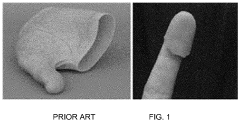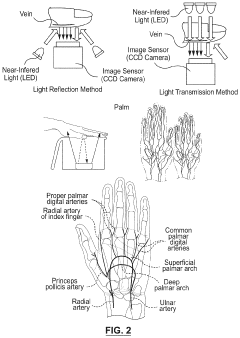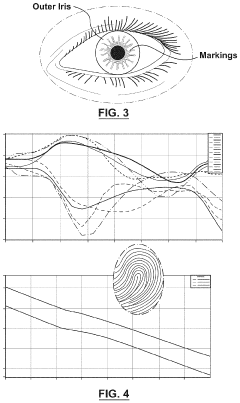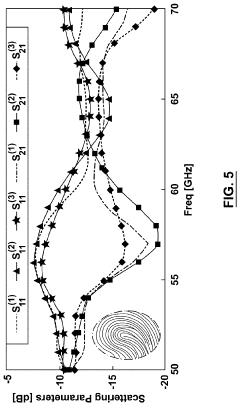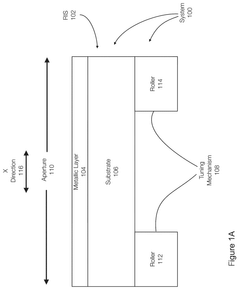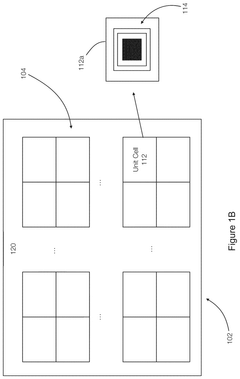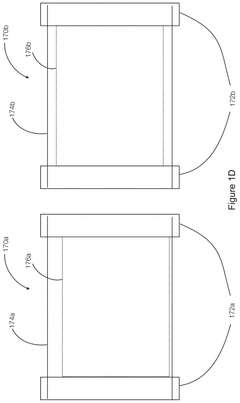Electromagnetic Waves in Smart City Solutions: A Closer Look
JUL 11, 20259 MIN READ
Generate Your Research Report Instantly with AI Agent
Patsnap Eureka helps you evaluate technical feasibility & market potential.
EM Wave Tech Evolution
The evolution of electromagnetic wave technology in smart city solutions has been marked by significant advancements and paradigm shifts. Initially, the application of EM waves in urban environments was limited to basic communication systems and rudimentary sensing technologies. However, as cities began to embrace digital transformation, the potential of EM waves in creating interconnected urban ecosystems became increasingly apparent.
In the early stages, the focus was primarily on improving wireless communication infrastructure. The deployment of 2G and 3G networks laid the foundation for mobile connectivity, enabling basic data transfer and voice communication. This period saw the emergence of simple sensor networks, primarily used for traffic management and environmental monitoring.
As smart city concepts gained traction, the evolution of EM wave technology accelerated rapidly. The introduction of 4G networks marked a significant leap forward, providing the bandwidth necessary for more sophisticated applications. This era witnessed the proliferation of Internet of Things (IoT) devices, leveraging EM waves for data collection and transmission across various urban systems.
The advent of 5G technology represents a pivotal moment in the evolution of EM wave applications in smart cities. With its ultra-low latency and high-bandwidth capabilities, 5G has opened up new possibilities for real-time data processing and analysis. This has enabled the development of advanced traffic management systems, intelligent energy grids, and enhanced public safety solutions.
Concurrently, advancements in radar and LiDAR technologies have revolutionized urban sensing capabilities. These EM wave-based systems provide high-resolution mapping and monitoring of urban environments, supporting applications ranging from autonomous vehicle navigation to infrastructure maintenance.
The integration of artificial intelligence and machine learning with EM wave technologies has further amplified their impact on smart city solutions. This synergy has led to the development of predictive maintenance systems for urban infrastructure, intelligent transportation networks that adapt in real-time to changing conditions, and sophisticated environmental monitoring platforms.
Looking ahead, the evolution of EM wave technology in smart cities is poised to continue its rapid trajectory. Emerging technologies such as terahertz communication and quantum sensing promise to push the boundaries of what is possible in urban data collection and transmission. These advancements are expected to enable even more granular and precise monitoring of urban environments, supporting increasingly sophisticated decision-making processes in city management.
In the early stages, the focus was primarily on improving wireless communication infrastructure. The deployment of 2G and 3G networks laid the foundation for mobile connectivity, enabling basic data transfer and voice communication. This period saw the emergence of simple sensor networks, primarily used for traffic management and environmental monitoring.
As smart city concepts gained traction, the evolution of EM wave technology accelerated rapidly. The introduction of 4G networks marked a significant leap forward, providing the bandwidth necessary for more sophisticated applications. This era witnessed the proliferation of Internet of Things (IoT) devices, leveraging EM waves for data collection and transmission across various urban systems.
The advent of 5G technology represents a pivotal moment in the evolution of EM wave applications in smart cities. With its ultra-low latency and high-bandwidth capabilities, 5G has opened up new possibilities for real-time data processing and analysis. This has enabled the development of advanced traffic management systems, intelligent energy grids, and enhanced public safety solutions.
Concurrently, advancements in radar and LiDAR technologies have revolutionized urban sensing capabilities. These EM wave-based systems provide high-resolution mapping and monitoring of urban environments, supporting applications ranging from autonomous vehicle navigation to infrastructure maintenance.
The integration of artificial intelligence and machine learning with EM wave technologies has further amplified their impact on smart city solutions. This synergy has led to the development of predictive maintenance systems for urban infrastructure, intelligent transportation networks that adapt in real-time to changing conditions, and sophisticated environmental monitoring platforms.
Looking ahead, the evolution of EM wave technology in smart cities is poised to continue its rapid trajectory. Emerging technologies such as terahertz communication and quantum sensing promise to push the boundaries of what is possible in urban data collection and transmission. These advancements are expected to enable even more granular and precise monitoring of urban environments, supporting increasingly sophisticated decision-making processes in city management.
Smart City Market Demand
The smart city market is experiencing rapid growth, driven by the increasing urbanization and the need for efficient, sustainable urban management. The demand for electromagnetic wave-based solutions in smart cities is particularly strong, as these technologies form the backbone of many smart city applications. Wireless communication networks, including 5G and future 6G technologies, are essential for connecting various smart city components, from IoT devices to autonomous vehicles.
One of the primary drivers of market demand is the need for improved urban mobility and transportation systems. Electromagnetic wave technologies enable real-time traffic management, smart parking solutions, and intelligent public transportation systems. These applications not only enhance the quality of life for citizens but also contribute to reducing carbon emissions and improving overall urban efficiency.
Energy management is another critical area where electromagnetic wave solutions are in high demand. Smart grids, which rely heavily on wireless communication, allow for more efficient distribution and consumption of electricity. This is particularly important as cities strive to integrate renewable energy sources and reduce their carbon footprint. The market for smart energy solutions is expected to grow significantly in the coming years, driven by government initiatives and increasing environmental awareness.
Public safety and security applications represent a substantial portion of the smart city market demand. Electromagnetic wave technologies enable advanced surveillance systems, emergency response networks, and disaster management solutions. These applications are becoming increasingly important as cities face new challenges related to climate change and urban security.
The healthcare sector is also driving demand for smart city solutions based on electromagnetic waves. Telemedicine, remote patient monitoring, and smart healthcare facilities all rely on robust wireless communication networks. The COVID-19 pandemic has further accelerated the adoption of these technologies, creating new opportunities in the market.
Environmental monitoring and management systems are gaining traction in smart cities worldwide. Electromagnetic wave-based sensors and communication networks allow for real-time monitoring of air quality, water resources, and waste management. This data-driven approach to environmental management is crucial for creating sustainable urban environments and meeting increasingly stringent environmental regulations.
The smart building sector is another significant contributor to market demand. Intelligent building management systems, which rely on wireless sensors and communication networks, optimize energy consumption, improve occupant comfort, and enhance building security. As cities focus on reducing their environmental impact, the demand for smart building solutions is expected to grow substantially.
In conclusion, the market demand for electromagnetic wave-based smart city solutions is diverse and rapidly expanding. From transportation and energy management to public safety and healthcare, these technologies are transforming urban environments and creating new opportunities for innovation and economic growth. As cities continue to evolve and face new challenges, the demand for advanced, interconnected solutions will only increase, driving further development and adoption of electromagnetic wave technologies in smart city applications.
One of the primary drivers of market demand is the need for improved urban mobility and transportation systems. Electromagnetic wave technologies enable real-time traffic management, smart parking solutions, and intelligent public transportation systems. These applications not only enhance the quality of life for citizens but also contribute to reducing carbon emissions and improving overall urban efficiency.
Energy management is another critical area where electromagnetic wave solutions are in high demand. Smart grids, which rely heavily on wireless communication, allow for more efficient distribution and consumption of electricity. This is particularly important as cities strive to integrate renewable energy sources and reduce their carbon footprint. The market for smart energy solutions is expected to grow significantly in the coming years, driven by government initiatives and increasing environmental awareness.
Public safety and security applications represent a substantial portion of the smart city market demand. Electromagnetic wave technologies enable advanced surveillance systems, emergency response networks, and disaster management solutions. These applications are becoming increasingly important as cities face new challenges related to climate change and urban security.
The healthcare sector is also driving demand for smart city solutions based on electromagnetic waves. Telemedicine, remote patient monitoring, and smart healthcare facilities all rely on robust wireless communication networks. The COVID-19 pandemic has further accelerated the adoption of these technologies, creating new opportunities in the market.
Environmental monitoring and management systems are gaining traction in smart cities worldwide. Electromagnetic wave-based sensors and communication networks allow for real-time monitoring of air quality, water resources, and waste management. This data-driven approach to environmental management is crucial for creating sustainable urban environments and meeting increasingly stringent environmental regulations.
The smart building sector is another significant contributor to market demand. Intelligent building management systems, which rely on wireless sensors and communication networks, optimize energy consumption, improve occupant comfort, and enhance building security. As cities focus on reducing their environmental impact, the demand for smart building solutions is expected to grow substantially.
In conclusion, the market demand for electromagnetic wave-based smart city solutions is diverse and rapidly expanding. From transportation and energy management to public safety and healthcare, these technologies are transforming urban environments and creating new opportunities for innovation and economic growth. As cities continue to evolve and face new challenges, the demand for advanced, interconnected solutions will only increase, driving further development and adoption of electromagnetic wave technologies in smart city applications.
EM Wave Challenges
The implementation of electromagnetic wave technologies in smart city solutions faces several significant challenges. One of the primary obstacles is the complex urban environment, which can cause signal interference and attenuation. Tall buildings, dense infrastructure, and various electronic devices create a challenging landscape for EM wave propagation, potentially leading to reduced signal quality and coverage.
Another critical challenge is the increasing demand for bandwidth and spectrum allocation. As smart cities continue to expand their wireless networks and IoT devices, the available frequency spectrum becomes increasingly congested. This congestion can result in reduced performance and reliability of EM wave-based systems, necessitating innovative approaches to spectrum management and utilization.
The issue of electromagnetic compatibility (EMC) also poses a significant challenge in smart city environments. With the proliferation of wireless devices and systems, ensuring that different EM wave-based technologies can coexist without causing harmful interference to one another becomes increasingly complex. This challenge requires careful planning and implementation of EMC standards and practices.
Energy efficiency is another crucial concern in the deployment of EM wave technologies for smart cities. Many wireless systems and sensors rely on battery power, and optimizing their energy consumption while maintaining performance is a delicate balance. Developing low-power EM wave solutions that can operate efficiently in urban environments is essential for the long-term sustainability of smart city initiatives.
Security and privacy concerns also present significant challenges in the context of EM wave technologies. As smart cities rely heavily on wireless communication for data transmission, protecting sensitive information from interception and ensuring the integrity of transmitted data become paramount. Implementing robust encryption and authentication mechanisms while maintaining system performance is a complex task.
Furthermore, the scalability of EM wave solutions in smart cities presents its own set of challenges. As urban populations grow and cities expand, the demand for wireless connectivity and IoT services increases exponentially. Designing EM wave systems that can scale effectively to accommodate this growth while maintaining performance and reliability is a significant engineering challenge.
Lastly, the integration of various EM wave technologies into a cohesive smart city ecosystem poses interoperability challenges. Ensuring seamless communication and data exchange between different systems and devices, often operating on different frequencies and protocols, requires careful standardization and coordination among various stakeholders in the smart city ecosystem.
Another critical challenge is the increasing demand for bandwidth and spectrum allocation. As smart cities continue to expand their wireless networks and IoT devices, the available frequency spectrum becomes increasingly congested. This congestion can result in reduced performance and reliability of EM wave-based systems, necessitating innovative approaches to spectrum management and utilization.
The issue of electromagnetic compatibility (EMC) also poses a significant challenge in smart city environments. With the proliferation of wireless devices and systems, ensuring that different EM wave-based technologies can coexist without causing harmful interference to one another becomes increasingly complex. This challenge requires careful planning and implementation of EMC standards and practices.
Energy efficiency is another crucial concern in the deployment of EM wave technologies for smart cities. Many wireless systems and sensors rely on battery power, and optimizing their energy consumption while maintaining performance is a delicate balance. Developing low-power EM wave solutions that can operate efficiently in urban environments is essential for the long-term sustainability of smart city initiatives.
Security and privacy concerns also present significant challenges in the context of EM wave technologies. As smart cities rely heavily on wireless communication for data transmission, protecting sensitive information from interception and ensuring the integrity of transmitted data become paramount. Implementing robust encryption and authentication mechanisms while maintaining system performance is a complex task.
Furthermore, the scalability of EM wave solutions in smart cities presents its own set of challenges. As urban populations grow and cities expand, the demand for wireless connectivity and IoT services increases exponentially. Designing EM wave systems that can scale effectively to accommodate this growth while maintaining performance and reliability is a significant engineering challenge.
Lastly, the integration of various EM wave technologies into a cohesive smart city ecosystem poses interoperability challenges. Ensuring seamless communication and data exchange between different systems and devices, often operating on different frequencies and protocols, requires careful standardization and coordination among various stakeholders in the smart city ecosystem.
Current EM Solutions
01 Electromagnetic wave detection and measurement
Various devices and methods for detecting and measuring electromagnetic waves are developed. These include sensors, antennas, and specialized equipment designed to capture and analyze electromagnetic signals across different frequencies and intensities.- Electromagnetic wave detection and measurement: Various devices and methods for detecting and measuring electromagnetic waves are described. These include sensors, antennas, and specialized equipment designed to capture and analyze electromagnetic signals across different frequencies and intensities.
- Electromagnetic wave shielding and protection: Technologies for shielding and protecting against electromagnetic waves are presented. These involve materials and structures designed to block or absorb electromagnetic radiation, protecting sensitive equipment or living organisms from potential harmful effects.
- Electromagnetic wave communication systems: Advancements in communication systems utilizing electromagnetic waves are discussed. These include improvements in wireless transmission, reception, and processing of electromagnetic signals for various applications such as mobile networks and satellite communications.
- Electromagnetic wave energy harvesting: Innovative methods for harvesting energy from electromagnetic waves are explored. These technologies aim to capture and convert ambient electromagnetic radiation into usable electrical energy for powering devices or supplementing power systems.
- Electromagnetic wave applications in medical field: Applications of electromagnetic waves in medical diagnostics and treatments are presented. These include imaging technologies, therapeutic devices, and monitoring systems that utilize various forms of electromagnetic radiation for medical purposes.
02 Electromagnetic wave shielding and protection
Technologies for shielding and protecting against electromagnetic waves are implemented in various applications. This includes materials and structures designed to block or absorb electromagnetic radiation, protecting sensitive equipment and living organisms from potential harmful effects.Expand Specific Solutions03 Electromagnetic wave communication systems
Advanced communication systems utilizing electromagnetic waves are developed for various applications. These systems include wireless data transmission, radar technology, and long-range communication methods that leverage the properties of electromagnetic waves for efficient and reliable information transfer.Expand Specific Solutions04 Electromagnetic wave energy harvesting
Innovative methods for harvesting energy from electromagnetic waves are explored. These technologies aim to capture and convert ambient electromagnetic radiation into usable electrical energy, potentially providing power for low-energy devices or supplementing existing power sources.Expand Specific Solutions05 Electromagnetic wave applications in medical field
The use of electromagnetic waves in medical applications is expanding. This includes diagnostic imaging techniques, therapeutic treatments, and monitoring systems that utilize various frequencies of electromagnetic radiation to improve healthcare outcomes and patient care.Expand Specific Solutions
Smart City EM Players
The electromagnetic wave technology for smart city solutions is in a growth phase, with increasing market size and evolving applications. The competitive landscape is characterized by a mix of established telecommunications companies, electronics manufacturers, and research institutions. Key players like ZTE Corp., Kyocera Corp., and Sony Group Corp. are leveraging their expertise in wireless communications and electronics to develop smart city applications. The technology's maturity varies across different use cases, with some areas like wireless connectivity well-established, while others like IoT sensors and data analytics platforms are still evolving. Companies such as Raytheon Co. and Hitachi Ltd. are contributing to advancements in sensor technologies and integrated systems, further driving innovation in this space.
ZTE Corp.
Technical Solution: ZTE Corp. has developed advanced electromagnetic wave solutions for smart cities, focusing on 5G network infrastructure. Their approach includes the deployment of small cell networks and massive MIMO technology to enhance coverage and capacity in urban environments[1]. ZTE's smart city solutions leverage electromagnetic waves for IoT connectivity, enabling real-time data collection and analysis for various applications such as traffic management, environmental monitoring, and public safety[2]. The company has also introduced innovative antenna designs that minimize electromagnetic interference while maximizing signal strength, crucial for dense urban areas[3].
Strengths: Strong expertise in 5G technology and network infrastructure; comprehensive smart city solutions. Weaknesses: Potential security concerns and international market access challenges due to geopolitical issues.
Raytheon Co.
Technical Solution: Raytheon Co. has developed sophisticated electromagnetic wave technologies for smart city applications, particularly in the realm of public safety and defense. Their approach includes advanced radar systems that can be integrated into urban environments for threat detection and monitoring[4]. Raytheon's smart city solutions also encompass electromagnetic spectrum management tools, which are crucial for optimizing wireless communications in densely populated areas[5]. The company has invested in developing electromagnetic pulse (EMP) protection systems for critical infrastructure, enhancing the resilience of smart city networks against potential threats[6].
Strengths: Cutting-edge defense and security technologies applicable to smart cities; expertise in electromagnetic spectrum management. Weaknesses: Primary focus on defense sector may limit broader smart city applications; potentially higher costs for civilian implementations.
Key EM Innovations
System and method for sensing with millimeter waves for sleep position detection, vital signs monitoring and/or driver detection
PatentActiveUS20210197834A1
Innovation
- A system utilizing millimeter-wave radar to transmit and receive electromagnetic waves between 30 GHz and 300 GHz for sleep position detection, vital sign monitoring, and driver distraction assessment, employing machine learning algorithms to analyze the signals and determine the position, vital signs, or driver distraction without the need for direct contact or bulky electrodes.
Flexible reconfigurable intelligent surface with mechanically tunable beam scanning
PatentPendingUS20250175888A1
Innovation
- A reconfigurable intelligent surface system with mechanically tunable beam scanning is achieved by using a flexible substrate installed on a rollable structure, allowing the aperture to be mechanically changed. This system employs a low-profile tuning mechanism that changes the exposed segment of the surface to steer the reflected beam, eliminating the need for intricate feed networks or complex mechanical systems.
EM Spectrum Regulations
The regulation of the electromagnetic spectrum is a critical aspect of smart city development, as it ensures the efficient and safe use of wireless technologies. In the context of smart city solutions, EM spectrum regulations play a pivotal role in managing the allocation and utilization of frequency bands for various applications.
At the international level, the International Telecommunication Union (ITU) oversees the global allocation of radio spectrum and satellite orbits. The ITU's Radio Regulations provide a framework for the harmonized use of radio frequencies across different regions and countries. These regulations are periodically updated through World Radiocommunication Conferences (WRCs) to address emerging technologies and changing spectrum needs.
National regulatory bodies, such as the Federal Communications Commission (FCC) in the United States and the Office of Communications (Ofcom) in the United Kingdom, are responsible for implementing and enforcing spectrum regulations within their respective jurisdictions. These agencies allocate frequency bands for specific uses, issue licenses, and monitor compliance with technical standards.
In smart city environments, spectrum regulations are particularly important for managing the coexistence of multiple wireless systems. For instance, the deployment of 5G networks, which are crucial for many smart city applications, requires careful coordination to avoid interference with existing services. Regulators have been working to identify and allocate suitable frequency bands for 5G, including both low-band and high-band spectrum.
The concept of dynamic spectrum access (DSA) is gaining traction in regulatory frameworks. DSA allows for more flexible and efficient use of spectrum by enabling devices to access available frequency bands on an opportunistic basis. This approach is particularly relevant for smart city applications, where the demand for wireless connectivity is constantly evolving.
Spectrum sharing mechanisms, such as Licensed Shared Access (LSA) and Citizens Broadband Radio Service (CBRS), are being implemented to maximize spectrum utilization. These frameworks allow multiple users to share spectrum bands under specific conditions, potentially increasing the availability of wireless resources for smart city solutions.
As the Internet of Things (IoT) continues to expand, regulators are also addressing the spectrum needs of low-power, wide-area networks (LPWAN) that support many smart city applications. Dedicated frequency bands for IoT devices, such as those in the sub-GHz range, are being allocated to facilitate the deployment of large-scale sensor networks and other IoT infrastructure.
At the international level, the International Telecommunication Union (ITU) oversees the global allocation of radio spectrum and satellite orbits. The ITU's Radio Regulations provide a framework for the harmonized use of radio frequencies across different regions and countries. These regulations are periodically updated through World Radiocommunication Conferences (WRCs) to address emerging technologies and changing spectrum needs.
National regulatory bodies, such as the Federal Communications Commission (FCC) in the United States and the Office of Communications (Ofcom) in the United Kingdom, are responsible for implementing and enforcing spectrum regulations within their respective jurisdictions. These agencies allocate frequency bands for specific uses, issue licenses, and monitor compliance with technical standards.
In smart city environments, spectrum regulations are particularly important for managing the coexistence of multiple wireless systems. For instance, the deployment of 5G networks, which are crucial for many smart city applications, requires careful coordination to avoid interference with existing services. Regulators have been working to identify and allocate suitable frequency bands for 5G, including both low-band and high-band spectrum.
The concept of dynamic spectrum access (DSA) is gaining traction in regulatory frameworks. DSA allows for more flexible and efficient use of spectrum by enabling devices to access available frequency bands on an opportunistic basis. This approach is particularly relevant for smart city applications, where the demand for wireless connectivity is constantly evolving.
Spectrum sharing mechanisms, such as Licensed Shared Access (LSA) and Citizens Broadband Radio Service (CBRS), are being implemented to maximize spectrum utilization. These frameworks allow multiple users to share spectrum bands under specific conditions, potentially increasing the availability of wireless resources for smart city solutions.
As the Internet of Things (IoT) continues to expand, regulators are also addressing the spectrum needs of low-power, wide-area networks (LPWAN) that support many smart city applications. Dedicated frequency bands for IoT devices, such as those in the sub-GHz range, are being allocated to facilitate the deployment of large-scale sensor networks and other IoT infrastructure.
EM Health Implications
The increasing deployment of electromagnetic (EM) wave-based technologies in smart city solutions has raised concerns about potential health implications for urban residents. While these technologies offer numerous benefits, such as improved connectivity and efficient resource management, it is crucial to examine their impact on human health and well-being.
Exposure to electromagnetic fields (EMFs) is a primary concern. Smart city infrastructure often relies on wireless communication networks, including 5G technology, which operates at higher frequencies than previous generations. This has led to debates about the potential biological effects of prolonged exposure to these EMFs. Some studies suggest that long-term exposure to high-frequency EMFs may lead to cellular stress, DNA damage, and oxidative stress, potentially increasing the risk of certain health issues.
However, it is important to note that the majority of scientific evidence indicates that EMF exposure from smart city technologies, when within established safety limits, does not pose significant health risks. Regulatory bodies such as the International Commission on Non-Ionizing Radiation Protection (ICNIRP) have set guidelines for EMF exposure, which are widely adopted by governments and industry.
Despite this, public perception and concerns about EMF exposure persist. Some individuals report experiencing electromagnetic hypersensitivity (EHS), characterized by symptoms such as headaches, fatigue, and cognitive difficulties when exposed to EMFs. While EHS is not recognized as a medical diagnosis, it highlights the need for further research and consideration of potential psychological factors in EMF-related health concerns.
The cumulative effect of multiple EMF sources in smart cities is another area of investigation. As the number of connected devices and sensors increases, the overall EMF exposure in urban environments may rise. This necessitates ongoing monitoring and assessment to ensure that the combined EMF levels remain within safe limits.
To address these concerns, smart city planners and technology developers are exploring ways to minimize EMF exposure while maintaining the benefits of EM wave-based solutions. This includes optimizing network designs to reduce the number of transmitters, implementing power control mechanisms to limit unnecessary emissions, and exploring alternative technologies that can complement or partially replace high-frequency EM wave systems.
In conclusion, while the current scientific consensus suggests that EM waves in smart city solutions do not pose significant health risks when properly regulated, ongoing research and vigilance are essential. As smart city technologies continue to evolve, it is crucial to maintain a balance between technological advancement and public health considerations, ensuring that the benefits of these innovations are realized without compromising the well-being of urban populations.
Exposure to electromagnetic fields (EMFs) is a primary concern. Smart city infrastructure often relies on wireless communication networks, including 5G technology, which operates at higher frequencies than previous generations. This has led to debates about the potential biological effects of prolonged exposure to these EMFs. Some studies suggest that long-term exposure to high-frequency EMFs may lead to cellular stress, DNA damage, and oxidative stress, potentially increasing the risk of certain health issues.
However, it is important to note that the majority of scientific evidence indicates that EMF exposure from smart city technologies, when within established safety limits, does not pose significant health risks. Regulatory bodies such as the International Commission on Non-Ionizing Radiation Protection (ICNIRP) have set guidelines for EMF exposure, which are widely adopted by governments and industry.
Despite this, public perception and concerns about EMF exposure persist. Some individuals report experiencing electromagnetic hypersensitivity (EHS), characterized by symptoms such as headaches, fatigue, and cognitive difficulties when exposed to EMFs. While EHS is not recognized as a medical diagnosis, it highlights the need for further research and consideration of potential psychological factors in EMF-related health concerns.
The cumulative effect of multiple EMF sources in smart cities is another area of investigation. As the number of connected devices and sensors increases, the overall EMF exposure in urban environments may rise. This necessitates ongoing monitoring and assessment to ensure that the combined EMF levels remain within safe limits.
To address these concerns, smart city planners and technology developers are exploring ways to minimize EMF exposure while maintaining the benefits of EM wave-based solutions. This includes optimizing network designs to reduce the number of transmitters, implementing power control mechanisms to limit unnecessary emissions, and exploring alternative technologies that can complement or partially replace high-frequency EM wave systems.
In conclusion, while the current scientific consensus suggests that EM waves in smart city solutions do not pose significant health risks when properly regulated, ongoing research and vigilance are essential. As smart city technologies continue to evolve, it is crucial to maintain a balance between technological advancement and public health considerations, ensuring that the benefits of these innovations are realized without compromising the well-being of urban populations.
Unlock deeper insights with Patsnap Eureka Quick Research — get a full tech report to explore trends and direct your research. Try now!
Generate Your Research Report Instantly with AI Agent
Supercharge your innovation with Patsnap Eureka AI Agent Platform!
